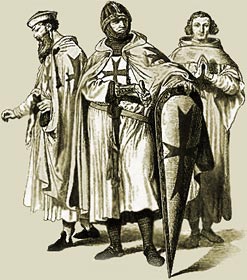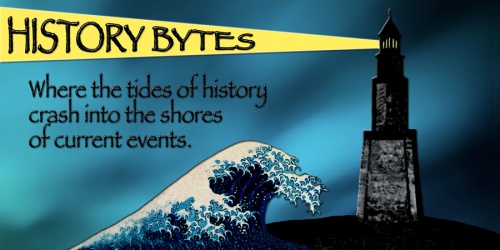And a description from CATHOLIC RADIO DRAMAS:
In 1571 Turkish Muslims amassed a huge naval fleet of galley ships in the Bay of Lepanto off the coast of Cyprus in an attempt to control the Mediterranean Sea, destroy the Christian fleet and invade the whole of Europe. Don Juan of Austria, the exiled illegitimate son of the king of Spain found himself selected as commander-in-chief of the outnumbered Christian fleet in what history would record as the bloodiest deck-to-deck sea battle in naval history.

Pope St. Pius V, a former Dominican monk, strove to unite the naval forces of Venice, Spain and the Holy See to meet the Muslim threat and entrusted the Christian fleet to the protection of the Blessed Virgin Mary. The pope sent his blessing to the fleet commander, Don John of Austria, recommending him to leave behind all soldiers of evil life, and promising him the victory if he did so. Realizing the importance of the impending battle, the pope ordered public prayers, and increased his own supplications to heaven and led the people of Rome in vigils and processions from dawn to dusk as they prayed the rosary to Our Lady of Victory.
The rosary became the spiritual weapon of the Christians as thousands joined together in prayer on the day of the Battle of Lepanto, October 7, 1571. That night while meeting with the cardinals, he suddenly stopped and opened the window and looking at the sky, he cried out, “A truce to business; our great task at present is to thank God for the victory which he has just given the Christian army”. He burst into tears over the victory which dealt the Muslim power a blow from which it never fully recovered. The decisive victory in the Bay of Lepanto destroyed all but a third of the enemy fleet and drove-off those that survived the conflict.
Pope Pius V established October 7 as a feast day of Our Lady of Victory in honor of the Blessed Virgin’s assistance in securing the victory, freeing some twelve thousand Christian galley slaves and securing the safety of Europe. In memory of this triumph he instituted the first Sunday of October the feast of the Rosary and added to the Litany of Loreto the supplication “Help of Christians”. He was hoping to put an end to the power of Islam by forming a general alliance between the Italian cities and those of Poland, France, and all of Christian Europe.
Two years later Pope Gregory XIII changed the name of the feast day to Our Lady of the Rosary because it was through the praying of the Rosary that the battle had been won. October became the month of the Most Holy Rosary in the Church’s calendar. Pope Leo XIII added the invocation “Queen of the Most Holy Rosary, pray for us” to the Litany of Loreto. Below, from various historical sources is the account of the battle.
Don John of Austria met his fleet off Messina and saw that he had 300 ships, great and small, under his command. The Pope himself had outfitted twelve galleys and the depth of his war chest had paid for many more. Don John’s eye must have gazed with pride on the 80 galleys and 22 other ships that had been provided by his half-brother Philip II of Spain. Each of these Spanish galleys held a hundred soldiers on top of the rowers who propelled the ship through the water and no less than 30,000 men in the service of Spain would fight at Lepanto. The next largest contingent was that of Venice. No longer the dominating power of yesteryear, the Venetians could still assemble a fleet of more than a hundred vessels beneath the winged Lion of St. Mark standard. The Venetian ships were poorly manned and the necessity of stationing Spanish soldiers on Venetian ships led to friction and in some cases blows.
It was the Venetians, however, who provided the technological cutting edge that was to win the battle. In the Venetian fleet were six galleasses. Broader in the beam than regular galleys and with a deeper draught they were so difficult to maneuver that they had to be towed into battle by speedier vessels. Despite their lethargy of movement, they were the most powerful ships in the Mediterranean. Their broad beam and deeper draught gave them a stability as a gun platform hitherto unknown. On their prow was constructed a kind of walled platform mounted with swivel guns that presaged the armored turrets of later battleships by almost 300 years. The sides and the stern of the galleass were also heavily armed and a wooden deck protected the rowers. On its bow there was a long point that could effectively crush any smaller vessel that was unfortunate enough to be in the galleass’ way. A total of 80,000 men manned the ships of the Holy League. Of these 50,000 toiled at the oars and the remaining 30,000 were soldiers on the decks.
On September 17th 1571, Don John moved his fleet eastwards and at Corfu they heard that the Muslims had recently landed and terrorized the Christian population. They then moved on and as they lay anchored off the coast of Cephalonia, terrible news reached them. Famagusta, the last Christian stronghold on Cyprus had fallen to the Muslim invaders. All the defenders who had survived the assault were tortured and then executed. The news enraged the men of Don John’s fleet and stiffened the resolve of the commanders to engage the Moslems as quickly as possible. There was one other piece of disturbing news: the Moslem fleet under the command of Ali Pasha had been reinforced by a Calabrian fisherman turned Moslem and corsair. His name was Uluch Ali and he was now the Bey of Algiers, that notorious nest of the Moslem corsairs feared by all Christian ships plying their trade in the Mediterranean. Don John moved his force towards the anchorage of Lepanto where he knew the Turk mercenaries would be waiting and during the night of October 6th, with a favorable wind behind him, Ali Pasha moved his fleet westward toward the mouth of the Gulf of Patras and the approaching ships of the Holy League.
The action that was to follow was the biggest naval engagement anywhere on the globe since the Battle of Actium in 30 B.C. and the tactics had changed little since then. Both commanders hoped to rapidly come to grips with their enemy, board them and let the soldiers fight it out to the end. The only major difference was that in 1571 the ships carried guns and those on the galleasses in particular would have a crucial effect. When the Turkish fleet was sighted, Don John split his force into three sections. On the right of the Christian line he placed the Venetians under Barbarrigo, on the left Andrea Doria leading the Genoese and papal galleys. The centre he took for himself. In reserve was Santa Cruz with a force of 35 Spanish and Venetian ships. Before the action began Don John ordered his men not to fire until they were close enough to be splashed by Moslem blood. He also ordered the iron rams to be removed from his ships as he knew that gunfire and close quarter fighting would be of more use than attempts to ram. Two galleasses were towed into position in in front of each Christian division.
The Turks, initially arrayed in a giant crescent-shaped formation, quickly separated into three sections also. The center, under Ali Pasha, pushed forward and the action opened when the cannon of Don John’s two centre galleasses began to do great execution among Ali Pasha’s advancing ships. Seven or more Turkish galleys went down almost immediately. The Turks were not lacking in courage, however, and they pressed on in the face of intense fire from the galleasses, the galleys’ guns and arquebus and crossbowmen on the Christian decks. Ali Pasha tried to come alongside the Christian ships in the hope of boarding and here the legendary steadfastness under fire of the 16th and 17th century Spanish infantryman came to the fore and attack after attack was beaten off by killing shots from their arquebuses. Then Don John gave the order to board Ali Pasha’s flagship. In a wild melee of attack, retreat and counterattack played out on decks awash with the blood of the slain, the air rent by the screams of the wounded and dying. The Spaniards forced their way onto the Turkish galley three times. Twice they were beaten back but finally they stormed the Turkish poop and a wounded Ali Pasha was beheaded on the spot. His head was spitted on a pike and held aloft for all to see and the Ottoman battle flag, never before lost in battle, was pulled down from the mainmast. The Moslem center broke and retired as best it could, their courage forgotten by the elated Spaniards.
On the flanks things had not gone so well. Mohammed Sirocco, commanding the Turkish right, sailed in close to the rocks and shoals of the northern shore of the gulf to outflank Barbarrigo’s Venetian galleys. On the left of the Turkish line Ulach Ali did the same, swinging as close as he could to the southern shore in an attempt to surround Andrea Doria’s ships. Sirocco knew well the waters of the Gulf Of Patras and he succeeded in his maneuver. Barbarrigo was surrounded by eight enemy galleys and fell dead from a Turkish arrow. His flagship was taken and retaken twice and when aid finally came and Sirocco’s galley was sunk, the Turkish admiral was ignominiously pulled from the water and, like Ali Pasha, immediately beheaded. Mercy was a quality not much in vogue in the wars between the crescent and the cross. On the Christian right, Ulach Ali, perhaps lacking the knowledge of local waters that had given Sirocco his initial success, was unable to turn the Genoese flank. He did, however, spot a gap in the line and skillfully brought some of his galleys through and took part of Don John’s center in the rear. The Capitana flagship of the Knights of St. John, its commander skewered by five arrows, was boarded, seized and towed off as a prize of battle. In the Christian reserve, Santa Cruz saw this happening and made haste to recover the captured ship. Uluch Ali, realizing that discretion is often the better part of valor, pulled back leaving the Capitana in Christian hands. Doria’s division had been roughly handled by Uluch Ali’s remaining ships and it was only after Don John had secured the Christian center and came to Doria’s aid that the last of the Algerine ships were beaten back.
The engagement lasted for more than four hours and when the smoke finally cleared it became apparent that this was a major victory for the Holy League and a bitter defeat for the Turks. Almost 8,000 of the men who had sailed with Don John were dead and another 16,000 wounded. On the brighter side 12,000 Christian galley slaves had been released from their servitude to the Ottomans. The Turks and Uluch Ali’s Algerines had suffered much more grievously: at least 25,000 of them had been killed.
The day belongs to Don John, the Holy League and Christendom. When the news of the victory broke, church bells were rung all over in Europe in a spontaneous outburst of joy and thanksgiving.































